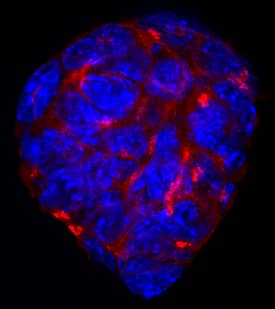Mouse Cripto Biotinylated Antibody
R&D Systems, part of Bio-Techne | Catalog # BAF1538


Key Product Details
Species Reactivity
Applications
Label
Antibody Source
Product Specifications
Immunogen
Arg26-Gln150
Accession # P51865
Specificity
Clonality
Host
Isotype
Scientific Data Images for Mouse Cripto Biotinylated Antibody
Cripto in D3 Mouse Cell Line.
Cripto was detected in immersion fixed D3 mouse embryonic stem cell line using Sheep Anti-Mouse Cripto Biotinylated Antigen Affinity-purified Polyclonal Antibody (Catalog # BAF1538) at 10 µg/mL for 3 hours at room temperature. Cells were stained using the NorthernLights™ 557-conjugated Streptavidin (red; Catalog # NL999) and counterstained with DAPI (blue). Specific staining was localized to cytoplasm and cell secretion. View our protocol for Fluorescent ICC Staining of Stem Cells on Coverslips.Applications for Mouse Cripto Biotinylated Antibody
Immunocytochemistry
Sample: Immersion fixed D3 mouse embryonic stem cell line
Western Blot
Sample: Recombinant Mouse Cripto (Catalog # 1538-CR)
Formulation, Preparation, and Storage
Purification
Reconstitution
Formulation
Shipping
Stability & Storage
- 12 months from date of receipt, -20 to -70 °C as supplied.
- 1 month, 2 to 8 °C under sterile conditions after reconstitution.
- 6 months, -20 to -70 °C under sterile conditions after reconstitution.
Background: Cripto
Cripto is the founding member of the epidermal growth factor-CriptoFRL1Cryptic (EGF-CFC) family of signaling proteins that function in cancer and various developmental processes. These developmental processes include: formation of the germ layers and dorsal organizer, specification of anterior-posterior and left-right axes, and differentiation of heart muscle (1, 2). Other members of the EGF-CFC family include Cryptic, Xenopus FRL-1 and zebrafish OEP (one-eyed pinhead). Overall sequence identity between members of the family is low, but they do share several common domains: a variant EGF-like motif, a novel conserved
cysteine‑rich domain (called CFC domain), and a C-terminal hydrophobic region. Most EGF-CFC members have a glycosyl-phosphatidylinositol (GPI) anchoring site at the C-terminus and exist as extracellular membrane-anchored proteins. However, naturally-occurring soluble isoforms also exist. Mouse Cripto shares 66% and 34% amino acid identity with human Cripto and zebrafish OEP, respectively (2). Despite weak conservation in amino acid identity, EGF-CFC family members appear to function similarly in assays for phenotypic rescue of zebrafish oep mutants (2). Both secreted and membrane bound forms of Cripto demonstrate biological activity (3).
Cripto, also known as CFC-2 or TDGF-1 (teratocarcinoma-derived growth factor), was originally isolated from an undifferentiated human teratocarcinoma cell line as a potential oncogene. It is overexpressed in many types of cancers and acts as a growth factor for tumors (4). Genetic evidence from mice and zebrafish points to a role for Cripto as an essential cofactor in Nodal signaling. Cripto and OEP mutants display defects in mesoderm induction and heart morphogenesis, similar to phenotypes seen in Nodal mutants (2).
Cripto acts as a cofactor for Nodal by recruiting the Activin type I Receptor, ALK-4, leading to an Act RIIB-ALK4-Cripto-Nodal complex for signaling (1, 3). Cripto also forms a complex with activin and Act RIIs to block activin signaling (5). Work has shown that other TGF-beta superfamily members such as Vg1 and GDF-1 also require EGF-CFC cofactors (6). Cripto can also activate mitogen-activated protein kinase (MAPK) and Akt pathways independently of Nodal by directly binding to a membrane-associated heparan sulfate proteoglycan, glypican-1 (7).
References
- Rosa, F.M. (2002) Science’s STKE http://stke.sciencemag.org/.
- Shen, M. and A. Schier (2000) Trends Genet. 16:303.
- Yan, Y-T. et al. (2002) Mol. Cell Biol. 22:4439.
- Salomon, D. et al. (2000) Endocrine-Rel. Cancer 7:199.
- Gray, P.C. et al. (2003) Proc. Natl. Acad. Sci. USA 100:5193.
- Cheng, S. et al. (2003) Genes & Dev. 17:31.
- Bianco, C. et al. (2003) Cancer Research 63:1192.
Long Name
Alternate Names
Gene Symbol
UniProt
Additional Cripto Products
Product Documents for Mouse Cripto Biotinylated Antibody
Product Specific Notices for Mouse Cripto Biotinylated Antibody
For research use only